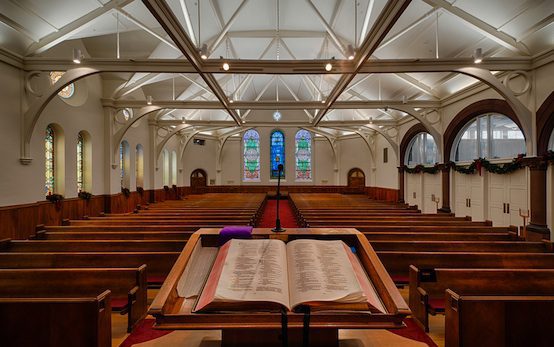
Still-closed houses of worship should be reopened as soon as possible for the health of our communities.
As churches, mosques, synagogues, and other religious institutions reopen and welcome communities back inside for prayer and gatherings, there are questions of how in-person engagement will change in light of the global pandemic. Even before COVID-19, the United States saw a huge rise in persons of no faith, as well as a decline in attendance and membership levels such that by 2020 only 47 percent of U.S. adults belonged to a church, synagogue, or mosque.
The number who will return in person to these sacred spaces is an open question and it is critical our religious institutions are prioritized, renewed, and reinvigorated as the nation reopens. These institutions fortify and stabilize the larger communities they are embedded in, and it is important that they remain diffused in secular, urban areas, not just in rural areas and small towns.
A survey of over 1,400 Americans sponsored by the Los Angeles Times and Reality Check Insights shows just how powerful engagement with a religious institution can be outside the church or temple itself.
The survey asked about fulfillment of the “American Dream” and various contributors to contentment with life. Real differences emerged when considering faith. Almost half of Americans who attend services a few times a month or more often believe they are living the American Dream, compared to a little under a third of those attending a few times a year or less often. When asked about the importance of contributing to one’s wider residential community, about a third of Americans who attend services only a few times a year (or less often) thought contributing to one’s community was essential. In contrast, over half of those who attend church a few times a month or more often thought communal contributions were essential—a significantly higher proportion.
Public policy should be crafted to help these institutions re-open as fast as possible and thrive, because they are the bedrocks of the civic and spiritual health of so many communities. While having a meaningful family life was equally important to those who regularly attend services and those who do not, family life is inward looking. Outward facing community contributions are essential for stability and social capital and the data show that Americans engaged with religious institutions are more focused on contributing to the larger world.
In addition to religious institutions helping prime wider community engagement, the data reveal that engagement improves marriage rates, another institution which strengthens communities and families. For those over 26, almost two-thirds who regularly attend religious services are married, compared to just over half who do not regularly attend services. The numbers of divorcees is twice as high for those who are religiously disconnected compared to those who regularly attend services. And regular church goers are a bit more likely to have children under 18 living at home compared to those who do not regularly attend, so the impact of participants in religious institutions in strengthening communities via schools and public amenities is apparent again.
Relatedly, while stories abound about religious Americans being out of touch with reality, the survey found little distinction about preferences for the diversity of a community from those who are religious. When asked about their ideal community, religious Americans were as open to a diverse community as those who were secular. Most preferred politically diversity; only 12 percent of regular practitioners and 8 percent of non-practitioners felt that living in an area where their neighbors shared political views was essential. Both religious and non-religious respondents had almost identical views in response to questions about community sharing a racial or ethnic background. When socio-economic status was queried, the differences were again minor. Collectively, this suggests that religious adherents are no more likely to segregate themselves from those who differ from them than are the non-affiliated.
Finally, religious Americans are distributed across the nation and not walled off into particular parts of the country. Contrary to the popular belief that rural areas are the domain of the religious and cities that of the secular “nones,” there are only minor religious differences by spatial area. Among those who rarely attend services, about a third live in cities, suburbs, and rural areas and small towns, respectively. Similarly, regular churchgoers are not dominant in rural areas and small towns either; almost 40 percent live in suburbs, another third live in cities, and barely 30 percent live in rural areas.
Highly engaged adherents are not balkanized by income and geographic location and new survey data show just how powerful being active in these institutions can be in terms of fortifying community and society. More active congregants are more likely to be married and remain married, as well as be concerned with improving the neighborhoods and communities in which they are embedded. These active congregants are really outward looking compared to those who are not affiliated with institutions of faith.
Policy makers should actively help reopen our religious centers. Given the positive impact of religious involvement on community health and institutions, states and localities should prioritize opening religious institutions, and the religious and lay leadership of these organizations should eagerly seek to re-engage and grow their congregations and communities.
Samuel J. Abrams is professor of politics at Sarah Lawrence College and a visiting scholar at the American Enterprise Institute.
No comments:
Post a Comment